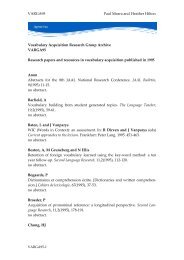A Note on Passive Vocabulary - Lognostics
A Note on Passive Vocabulary - Lognostics
A Note on Passive Vocabulary - Lognostics
Create successful ePaper yourself
Turn your PDF publications into a flip-book with our unique Google optimized e-Paper software.
Meara 1990<br />
Figure 1:<br />
Direct intercity air routes in Sweden (in 1990)<br />
Su<br />
Go<br />
N<br />
Figure 2:<br />
An architectural design with the same graph structure as Figure 1.<br />
associati<strong>on</strong>s (arcs). The associati<strong>on</strong>s are directi<strong>on</strong>al; even though all the words are<br />
c<strong>on</strong>nected to the network as a whole, you can <strong>on</strong>ly move from <strong>on</strong>e word to another in<br />
the directi<strong>on</strong>s indicated by the arrows. In real life, this corresp<strong>on</strong>ds to the fact that<br />
associati<strong>on</strong>s are not generally symmetrical: for instance CABBAGE will often elicit white<br />
or green as associati<strong>on</strong>s, but not vice versa.<br />
The interesting case for us is node H in Figure 4. This node is clearly part of the overall<br />
network structure, but its place in the network is very different from that of all the other<br />
nodes. The other nodes are c<strong>on</strong>nected to the network by two kinds of arcs: each node<br />
has arcs which lead to it, and other arcs which lead away from it. Node H <strong>on</strong>ly has nodes<br />
Jo<br />
St<br />
Ma K<br />
Su Go<br />
Jo St Ma<br />
N K<br />
2



